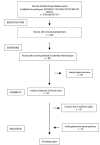A Review of the Major Prosthetic Factors Influencing the Prognosis of Implant Prosthodontics
- PMID: 33671394
- PMCID: PMC7921991
- DOI: 10.3390/jcm10040816
A Review of the Major Prosthetic Factors Influencing the Prognosis of Implant Prosthodontics
Abstract
Background: The treatment plan of prosthetic restorations supported by dental implants requires comprehensive scientific knowledge to deliver prostheses with good prognosis, even before the implant insertion. This review aims to analyze the main prosthetic determinants of the prognosis of implant-supported prostheses.
Methods: A comprehensive review of the literature was conducted with a PICO (Patient Intervention Comparison Outcomes) question: "For partially or complete edentulous subjects treated with implant-supported prostheses, which prosthetic factors could affect clinical outcomes?". A literature search was performed electronically in PubMed (MEDLINE), Scopus and Cochrane Library with the following equation [PROGNOS * OR RISK] FACTOR IMPLANT DENTAL, and by hand search in relevant journals and throughout the selected papers.
Results: This revision was carried out based on 50 papers focused on several prosthodontics-related risk factors that were grouped as follows: implant-connection, loading protocol, transmucosal abutments, prosthetic fit, provisionalization, type of retention, impression technique, fabrication technique, and occlusion. More than a half of the studies were systematic reviews (30%), meta-analysis (16%), or prospective evaluations of prosthesis with various kinds of events (18%). However, narrative reviews of literature (14%) and in vitro/animal studies (16%) were also found.
Conclusions: The current literature provides insufficient evidence for most of the investigated topics. However, based on the accumulated data, it seems reasonable to defend that the best treatment approach is the use of morse taper implants with transmucosal abutments, recorded by means of rigidly splinted copings through the pick-up technique, and screwed by milled prosthesis occlusally adjusted to minimize functional overloading.
Keywords: clinical performance; dental implant; prognosis; prosthodontics; risk factor.
Conflict of interest statement
The author declares no conflict of interest.
Figures
References
-
- Academy of Osseointegration 2010 Guidelines of the Academy of Osseointegration for the provision of dental implants and associated patient care. Int. J. Oral Maxillofac. Implants. 2010;25:620–627. - PubMed
-
- Pjetursson B.E., Thoma D., Jung R., Zwahlen M., Zembic A. A systematic review of the survival and complication rates of implant-supported fixed dental prostheses (FDPs) after a mean observation period of at least 5 years. Clin. Oral Implants Res. 2012;23:22–38. doi: 10.1111/j.1600-0501.2012.02546.x. - DOI - PubMed
Publication types
LinkOut - more resources
Full Text Sources
Other Literature Sources




